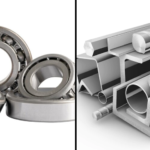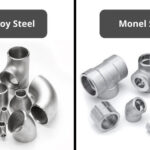What is Inconel, exactly?
Inconel is an oxidation-corrosion-resistant alloy that works well in high-temperature and high-pressure environments. When Inconel alloy is heated, a thick, stable oxide layer forms on the surface, protecting it from further attack. The strength of Inconel extends over a wide temperature range. It produces high-temperature strength through solid solution strengthening or precipitation hardening, depending on the alloy. Inconel is a high-temperature metal that is extensively utilized in a variety of applications.
Chemical Make-Up of Inconel
| Inconel Grade | Ca | Mg | sl | Ph | Ch | Si | My | Ni | Cob | Co | Al | ||||
| Inconel 600 | 0.15 | 1.00 | 0.015 | – | 14.0–17.0 | 0.50 | – | – | – | 0.50 | – | ||||
| Inconel 617 | 0.15 | 0.50 | 0.015 | 0.015 | 20.0–24.0 | 0.50 | 8.0–10.0 | – | 10.0–15.0 | 0.50 | 0.8–1.50 | ||||
| Inconel 625 | 0.10 | 0.50 | 0.015 | 0.015 | 20.0–23.0 | 0.50 | 8.0–10.0 | 3.15–4.15 | 1.00 | – | 0.40 | ||||
| Inconel 690 | 0.019 | 0.35 | 0.003 | – | 30.0max | 0.35 | – | – | – | 0.01 | 0.02 | ||||
| Inconel 718 | 0.08 | 0.35 | 0.015 | 0.015 | 17.0–21.0 | 0.35 | 2.8–3.3 | 4.75–5.5 | 1.00 | 0.2–0.8 | 0.65–1.15 | ||||
| Inconel X-750 | 0.08 | 1.00 | 0.01 | – | 14.0–17.0 | 0.50 | – | 0.7–1.2 | 1.00 | 0.50 | 0.4–1.0 |
Mechanical Properties of Inconel
| Inconel Grade | Tensile Strength | Yield Strength (0.2%Offset) | Density | Melting Point | Elongation |
| Inconel 600 | Psi – 95,000 , MPa – 655 | Psi – 45,000 , MPa – 310 | 8.47 g/cm3 | 1413 °C (2580 °F) | 0.4 |
| Inconel 601 | Psi – 80,000 , MPa – 550 | Psi – 30,000 , MPa – 205 | 8.1 g/cm3 | 1411 °C (2571 °F) | 0.3 |
| Inconel 617 | ≥ 485 MPa | ≥ 275 MPa | 8.3g/cm³ | 1363°C | 0.25 |
| Inconel 625 | Psi – 135,000 , MPa – 930 | Psi – 75,000 , MPa – 517 | 8.4 g/cm3 | 1350 °C (2460 °F) | 0.425 |
| Inconel 690 | ≥ 485 MPa | ≥ 275 MPa | 8.3g/cm³ | 1363°C | 0.25 |
| Inconel 718 | Psi – 135,000 , MPa – 930 | Psi – 70,000 , MPa – 482 | 8.2 g/cm3 | 1350 °C (2460 °F) | 0.45 |
| Inconel 725 | 1137 MPa | 827 MPa | 8.31 g/cm3 | 1271°C-1343 °C | 0.2 |
| Inconel X-750 | 1267 MPa | 868 MPa | 8.28 g/cm3 | 1430°C | 0.25 |
Grade of Inconel Equivalent
| Standard | WNR | UNS | AFNOR | JIS | BS | EN |
| Inconel 600 | 2.4816 | N06600 | NC15FE11M | NCF 600 | NA 13 | NiCr15Fe |
| Inconel 601 | 2.4851 | N06601 | NC23FeA | NCF 601 | NA 49 | NiCr23Fe |
| Inconel 617 | 2.4663 | N06617 | ||||
| Inconel 625 | 2.4856 | N06625 | NC22DNB4M | NCF 625 | NA 21 | NiCr22Mo9Nb |
| Inconel 690 | 2.4642 | N06690 | ||||
| Inconel 718 | 2.4668 | N07718 | ||||
| Inconel 725 | – | N07725 | ||||
| Inconel X-750 | 2.4669 | N07750 |
What is Hastelloy, exactly?
Hastelloy is a high-melting-point nickel-molybdenum alloy. It comes in a range of grades, with nickel-chromium molybdenum alloys accounting for the majority of them. Despite the fact that each Hastelloy grade was created for a distinct application, they are all extremely corrosion resistant. With the addition of, Hastelloy becomes stronger and tougher at high temperatures, making it perfect for welding applications. It’s easy to shape and put together. They may be forged and cold worked due to their ductility. Hastelloy is a suitable choice for high-temperature applications because of its outstanding resistance to strongly oxidising and reducing chemicals. In the chemical and petrochemical sectors, it’s frequently utilised for pipes and valves. It’s an excellent heat exchanger and pressure vessel material, and it’s also utilised in nuclear and chemical reactors.
Chemical Make-Up of Hastelloy
| Alloy | Carbon | Cobalt | Chromium | Molybdenum | Vanadium | Tungsten | Aluminium | Copper | Niobium | Titanium | Iron | Nitrogen | Other% |
| B | 0.10max | 1.25max | 0.60max | 28.00max | 0.30max | – | – | – | – | – | 5.50max | Bal | Mn 0.80; Si 0.70 |
| B2 | 0.02max | 1.00max | 1.00max | 26.0-30.0 | – | – | – | – | – | – | 2.00max | Bal | Mn 1.0, Si 0.10 |
| C | 0.07max | 1.25max | 16.00max | 17.00max | 0.30max | 40.0max | – | – | – | – | 5.75max | Bal | Mn 1.0; Si 0.70 |
| C4 | 0.015max | 2.00max | 14.0-18.0 | 14.0-17.0 | – | – | – | – | – | 0.70max | 3.00max | Bal | Mn 1.0 ; Si 0.08 |
| C276 | 0.02max | 2.50max | 14.0-16.5 | 15.0-17.0 | 0.35max | 3.0-4.5 | – | – | – | – | 4.0-7.0 | Bal | Mn 1.0; Si 0.05 |
| G | 0.05max | 2.50max | 21.0-23.5 | 5.5-7.5 | – | 1.00max | – | 1.5-2.5 | 1.7-2.5 | – | 18.0-21.0 | Bal | Mn 1.0-2.0; P0.04; Si 1.0; |
| N | 0.06max | 0.25max | 7.00max | 16.50max | – | 0.20max | – | 0.10max | – | – | 3.00max | Bal | Mn 0.40; Si 0.25; B 0.01 |
| S | 0.02max | 2.00max | 15.50max | 14.50max | 0.60max | 1.00max | 0.20max | – | – | – | 3.00max | Bal | Mn 0.50; Si 0.40; B0.0009; La 0.02 |
| W | 0.06max | 1.25max | 5.00max | 24.50max | – | – | – | – | – | – | 5.50max | Bal | Mn 0.050; Si 0.50 |
| X | 0.10max | 1.50max | 22.0max | 9.00max | – | 0.60max | – | – | – | 18.50max | – | Bal | Mn 0.6; Si 0.60 |
Mechanical Properties of Hastelloy
| Alloy | Tensile Strength | Yield Strength (0.2%Offset) | Density | Melting Point | Elongation |
| Alloy C22 | Psi – 1,00,000 , MPa – 690 | Psi – 45000 , MPa – 310 | 8.69 g/cm3 | 1399 °C (2550 °F) | 0.45 |
| Alloy C276 | Psi – 1,15,000 , MPa – 790 | Psi – 52,000 , MPa – 355 | 8.89 g/cm33 | 1370 °C (2500 °F) | 0.4 |
| Alloy B2 | Psi – 1,15,000 , MPa –760 | Psi – 52,000 , MPa – 350 | 9.2 g/cm3 | 1370 °C (2550 °F) | 0.4 |
| Alloy B3 | Psi – 1,15,000 , MPa –760 | Psi – 52,000 , MPa – 350 | 9.2 g/cm3 | 1370 °C (2550 °F) | 0.4 |
| Alloy C4 | 783 | 365 | 8.64 g/cm3 | 1350-1400 °C | 0.55 |
| Alloy X | 655 MPa | 240 MPa | 8.22 g/cm³ | 1355°C | 0.35 |
Equivalent Hastelloy Grade
| Alloy | WNR | UNS | GOST | JIS | EN |
| C22 | 2.4602 | N06022 | – | NW 6022 | NiCr21Mo14W |
| C276 | 2.4819 | N10276 | ХН65МВУ | NW 0276 | NiMo16Cr15W |
| B2 | 2.4617 | N10665 | – | – | – |
| B3 | 2.46 | N10675 | – | – | – |
| C4 | 2.461 | N06455 | – | – | – |
| C-22 | – | N07022 | – | – | – |
| C2000 | 2.4675 | N06200 | – | – | – |
| X | 2.4665 | N06002 | – | – | – |



